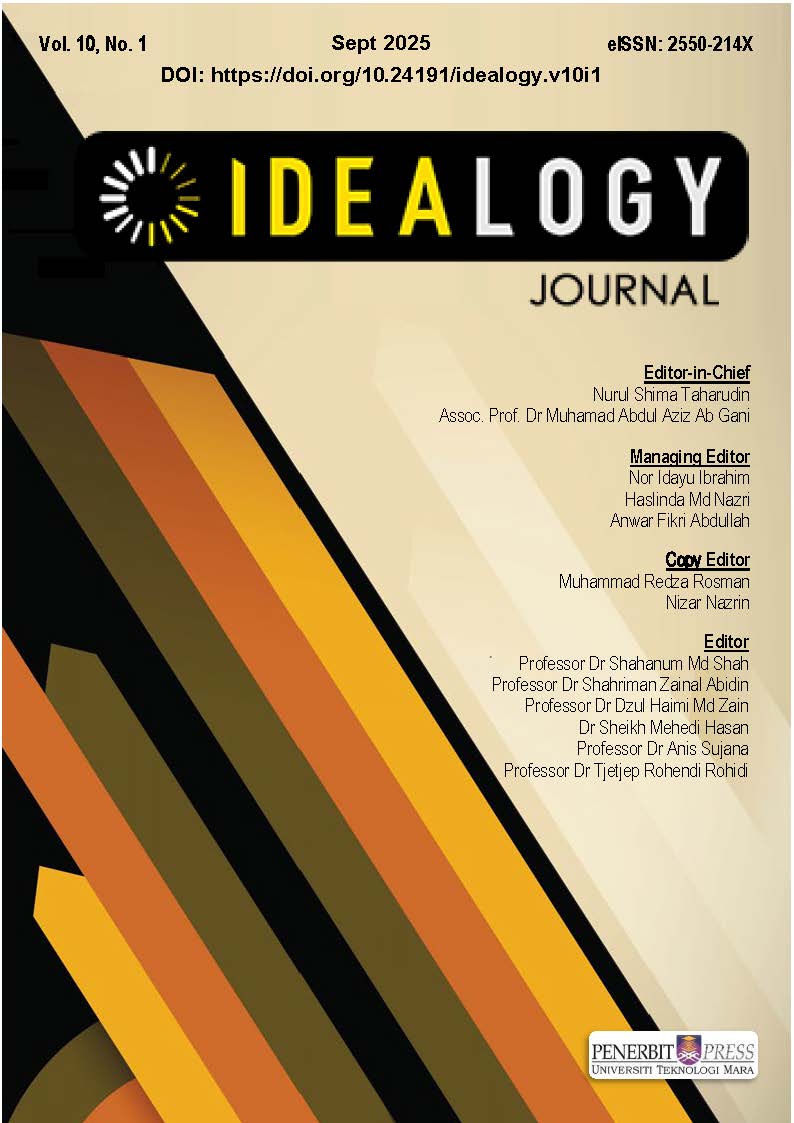Analysis of the Color Characteristics of Jiaodong Paper-Cutting Art in "Calabash Brothers" Based on the Perspective of Barthes’s Semiotic
DOI:
https://doi.org/10.24191/idealogy.v10i1.724Keywords:
Jiaodong Paper-Cut Art,Abstract
Based on Barthes’s semiotic perspective, this study deeply analyses the colour design characteristics of Jiaodong paper-cutting art in the classic animation "Calabash Brothers". The study uses qualitative research methods to explore how it conveys deep cultural connotations and emotional expressions through visual elements, aiming to reveal the semiotic significance and visual expression of traditional folk art in modern film and television works. Through the theoretical framework of Barthes's semiotics and from the two levels of "signifier" and "signified" of symbols, we analyse how the formal characteristics and cultural connotation of Jiaodong paper-cutting art are inherited and reproduced in "Calabash Brothers".The article first sorts out the unique visual language of Jiaodong paper-cut art, including its use of bright primary colours, strong colour contrast, and expression of emotional tension. Secondly, it explores how these characteristics are reflected in animation and form a distinctive national artistic style. The "Calabash Brothers" cartoon absorbs the essence of Jiaodong paper-cutting art and recreates it through the animation medium, which not only gives new vitality to traditional art, but also enhances the expressiveness and communication power of its symbols. This analysis aims to provide theoretical support for the modern application of traditional art and promote its new vitality in a broader cultural context.
Keywords: Jiaodong Paper-Cut Art, "Calabash Brothers", Colour Characteristics, Semiotic Analysis, Chinese Paper-Cut Animation
References
Denzin, N. K., & Lincoln, Y. S. (Eds.). (2021). The SAGE handbook of qualitative research.
Fang Tian, (2025). The Embodiment of Philosophy in Traditional Chinese Colour Paper-Cutting Art. Cultura. International Journal of Philosophy of Culture and Axiology 22(1): 104-120
Gao, Q., & Gao, Y. (2024). From artistic integration to imagery rebirth: The aesthetic construction of Chinese paper-cut animation (1958–2002). *Art Observation*, (10), 129–131.
Krippendorff, K. (2018). Content analysis: An introduction to its methodology (4th ed.). SAGE Publications.
Meng, X. P. (2020). Window flower system: The cluster presentation of Jiaodong folk paper-cutting. Decoration.
Pasya, R. A. D., & Rahayu, D. (2024). Semiotic analysis found in selected Christopher Nolan's movie posters. Proceedings Series on Social Sciences & Humanities, 18, 320-330. https://doi.org/10.30595/psshv18i1269
Ramadany, R., Hasyim, M., & Sukma, S. (2024). Roland Barthes’ semiotics analysis of characters from Liyue in the game Genshin Impact. Journal of Maobi, 2(1), 1–15. https://doi.org/10.20961/maobi.v2i1.85101
Ren, S. S. (2016). An overview of Jiaodong paper-cutting. Fine Arts, (12), 151. https://doi.org/10.13864/j.cnki.cn11-1311/j.002385
Sun, P., & Huo, X. Y. (2019). Interpretation of character symbols and social psychology in the animated series *Calabash Brothers*. *China Radio and Television Journal*, (12), 72–74.
Wang, M. N. (2018). A study of the cultural connotation of the animated image of Sun Wukong in China and Japan from a semiotic perspective (Master’s thesis, Anhui University of Engineering). Retrieved from https://kns.cnki.net/kcms2/article/abstract?v=VcTOyLYtvExTYITmn0sVydyaAtOKP82Q5oV5zD9dGt3psf8IWNpqlIE-PzVym7_Itf9AWZOYCjx3c0TDkobLQ77pHpKV0FNoE2p30-7WvuANQOs4wtRNLZ8jPSaBFjWagO3raBTHrqT-Q_iARhAlaH5_M97A_rIL5TPHFXUSGCdSyJ8xa8FX4Dh8u9YDt3O_uLSTbJNWwWo=&uniplatform=NZKPT&language=CHS
Xue, J., & Li, M. Y. (2022). Visual characteristics analysis of traditional patterns in Jiaodong paper-cutting. Paper Information, (05), 76–77.
Yapis Biak. (2024). Semiotic analysis in advertising: How messages are communicated to society. Mohamad Sudi Institut Ilmu Sosial dan Ilmu Politik (ISIP) Journal of Communication, 2(3), 224-235. e-ISSN: 2988-1331.
Yang, Q. (2023). Contemporary Chinese landscape paintings: genealogies of form. Journal of Visual Art Practice, 22(4), 347-371.
Zeng, F. J. (2015). Analysis of the nationalized characteristics in character design of the animated series *Calabash Brothers*. *Art & Technology*, (06), 56.
Zhang, J. (2013). On Roland Barthes' semiotics and visual communication theory. Humanities Journal, (09), 70-74. https://doi.org/10.15895/j.cnki.rwzz.2013.09.002
Zhang, L. (2020). A semiotic perspective on the construction of the Japanese animation sign system and audience consumption (Doctoral dissertation, Jilin University). https://link.cnki.net/doi/10.27162/d.cnki.gjlin.2020.000100
Zhang, Y. Y. (2020). Research on the image production of "Telling China's Story Well": An interpretation of Chinese elements in *Calabash Brothers*. *The Drama Home*, (22), 123–124.
Ziwei, Z., Aris, A. B., & Ahmad, H. B. (2024). Research on the Application of Chinese Paper-cutting Craft in Modern Fashion Design. Idealogy Journal, 9(2).
Downloads
Published
Issue
Section
License
Copyright (c) 2025 Idealogy Journal

This work is licensed under a Creative Commons Attribution-NonCommercial-NoDerivatives 4.0 International License.
UiTM Press (the Publisher) has agreed to publish the undersigned author’s paper in Idealogy Journal. The agreement is contingent upon the fulfilment of a number of requirements listed below.
1. The undersigned author warrants that the paper entitled below is original, that it is not in any way libellous or unlawful in Malaysia, that it does not infringe any copyright or other proprietary right. The undersigned hereby represents and warrants that he/she is the author of the paper, except for material that is clearly identified as to its original source, with permission notices from the copyright owners where required. The undersigned represents that he/she has the power and authority to sign and execute this agreement.
2. The undersigned author warrants that the paper entitled below has not been published elsewhere, and also it will not be submitted anywhere else for publication prior to acceptance/rejection by this Journal.
3. By submitting the paper entitled below, the undersigned author agrees to transfer the rights to publish and distribute the paper in an international e-journal (entitled above) to Publisher.
4. The undersigned author agrees to make a reasonable effort to conform to Publisher's submission guidelines and to liaise with the editor to ensure that the requirements of these guidelines are met to a reasonable degree.
5. The corresponding author signs for and accepts responsibility for releasing this material on behalf of any and all coauthors. This agreement is to be signed by at least one of the authors who has obtained the assent of the co-author(s) where applicable. After submission of this agreement signed by the corresponding author, changes of authorship or in the order of the authors listed will not be accepted.


